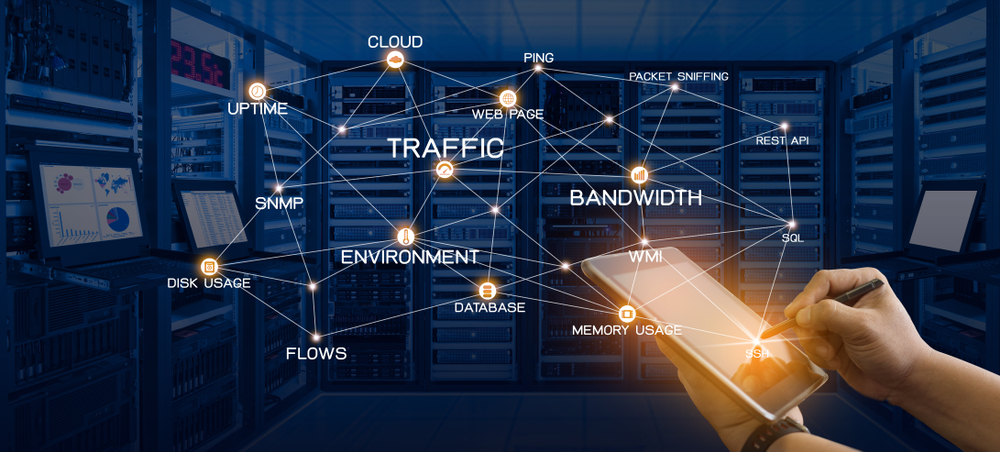
A well-functioning network is essential to any organisation. It facilitates communication, data exchange, and most importantly, the seamless operation of your business. If your network should fail, you can expect downtimes, outages, and disruption to strike your customers.
Avoidable? Yes.
With the right monitoring and alerting mechanisms, it’s possible to identify and rectify problems before they cause any damage. In this article, we will explore the world of monitoring and alerts. The significance of a proactive approach in ensuring the stability, security, and performance of your entire network ecosystem will become apparent.
Understanding Network and Infrastructure Monitoring
What do we mean when we talk about network and infrastructure monitoring?
Network and infrastructure monitoring is a comprehensive and proactive approach to overseeing the health, performance, and security of your organisation’s interconnected systems.
It involves the continuous tracking of key metrics, data points, and events within a network, including elements such as servers, devices, storage infrastructure, and network control components like load balancers and firewalls. By collecting and analysing data in real time, an effective monitoring method enables your IT provider to detect and mitigate any issues or potential security threats early, before they have the opportunity to do any damage. As a result, resources are optimised and your entire network ecosystem can perform at its best in a safe environment.
Do I need a monitoring and alerts system?
Simply put, yes!
A monitoring and alerts system is essential to maintain the health, performance, and security of your IT infrastructure by acting as the proverbial ‘early warning system’. Without one, you risk being unaware of issues until they manifest as critical problems that cause service disruptions, downtime, and potential financial losses.
In comparison, businesses who proactively opt for monitoring and alerting systems can detect anomalies, bottlenecks, and performance degradation in real-time, allowing them to take immediate corrective actions.
In a world where data security and compliance are paramount, the benefit of this is enormous. Timely alerts enable IT and security teams to investigate and mitigate threats, protecting sensitive data and maintaining regulatory compliance. In essence, such a system is a crucial component of an organisation’s risk management strategy, ensuring that potential security incidents are addressed before they escalate into major breaches. By detecting and responding to security breaches and suspicious activities swiftly, you not only minimise the impact but also improve your operational efficiency and can even realise cost savings.
In fact, the risks of not having an effective monitoring and alerts system can include:
- Service disruption leading to downtime and financial loss
- Slow or inefficient systems that harm employee productivity and customer satisfaction
- Security breaches
- Data loss
- Compliance violations resulting in legal consequences and reputational damage.
- Inefficient Resource Allocation: Without monitoring, businesses may overprovision or underutilize resources, wasting time and money.
- Reduced customer trust and loyalty thanks to frequent service disruptions
- Increased IT cost
- Ineffective incident response
What do I need to monitor?
An effective monitoring and alerts system should monitor a wide range of parameters and components within your organisation’s IT infrastructure to ensure the health, performance, and security of the systems. Key elements to monitor include:
Network Infrastructure
- Network traffic and bandwidth utilisation
- Network latency and packet loss
- Router and switch performance
Security and network control devices
- Firewall and security device logs
- Load Balancers
- Proxy Servers
- AntiVirus Applications
- VPN Concentrators
- IDS Devices
Servers
- CPU, memory, and disk utilisation
- Operating system performance
- Server availability and response time
- Event logs for error messages and warnings
Applications and workstations
- Application availability and response time
- Database performance and query execution times
- Web server performance and error rates
- Transaction processing and application-specific metrics
- Event logs
Security and Threat Detection
- Intrusion detection and prevention
- Anomaly detection for unusual network behaviour
- Firewall rule violations and security event logs
- Vulnerability scanning and patch management status
Storage Infrastructure:
- Storage capacity and utilisation
- Disk I/O and latency
- Data backup and recovery status
- Disk health and SMART data for storage devices

An effective monitoring and alerts system should offer the flexibility to configure alerts based on your unique thresholds and conditions. The right partner should also be able to offer you custom metrics specific to your individual needs and services, alongside custom scripts or plugins for monitoring specialised applications or devices. At Proxar, we pride ourselves on our tailored approach, offering our partners only what they want and need, rather than including hefty bolt-ons.
Best practices for effective monitoring and alerts
Let’s dive into what you need to look out for in an effective monitoring and alerts system.
Monitoring thresholds
The last thing you want your monitoring system to do is to overload you with data. You want to avoid overly aggressive settings that generate excessive alerts and lead to alert fatigue while ensuring that thresholds are set at levels that capture anomalies and performance degradation.
That’s why it’s essential to establish thresholds that strike a balance between sensitivity, reliability, and relevance. To achieve this balance, thresholds should be based on historical data and performance benchmarks, considering both normal and peak usage patterns. As the environment evolves, these should be regularly reviewed and adjusted.
At this stage, collaboration between IT teams and stakeholders is essential to determine the thresholds that align with business priorities and end-user expectations, ultimately optimising the effectiveness of the monitoring system. Here, an outsourced team can be particularly valuable to navigate the business necessities, stakeholders, and technical requirements.
Reducing false alerts
Reducing false alerts is vital to maintaining the effectiveness of a monitoring system and preventing alert fatigue among IT staff. To achieve this, you can implement:
- Hysteresis. This introduces a margin of error around alert thresholds to filter out transient fluctuations and minor deviations.
- Baseline comparison. Here, baseline performance metrics are established and alerts are generated only when metrics deviate significantly from the baseline.
- Outlier detection algorithms and machine learning models. These can help identify genuine anomalies while reducing the noise of false alerts.
- Fine tuning from IT professionals. Coupled with regular audits of alerting rules, the right IT team can refine your alerting system to focus your alerting system.
If this sounds outside the realm of your inhouse expertise, Proxar can help answer any questions you might have.
Automated responses to alerts
Automated responses to alerts are essential for rapid issue resolution, day or night. A systematic approach involving the following steps is best practice for your internal team or outsourced IT partner to follow:
- Alert Prioritization: Start by categorising and prioritising alerts based on their severity and potential impact on the organisation. Not all alerts require immediate automated responses, and focusing on critical alerts is essential.
- Alert Integration: Integrate your monitoring system with automation tools, incident management platforms, and orchestration solutions.
- Create Playbooks: Develop detailed playbooks that outline the specific actions to be taken in response to different types of alerts, including decision points, conditions, and sequences of automated tasks.
- Automation Logic: Implement logic in your automation scripts to handle complex scenarios. For example, your IT partner should create conditional statements that adapt responses based on the context of the alert and the current system state.
- Testing and Validation: Thoroughly test your automated response workflows in a controlled environment to ensure they work as intended while considering edge cases and potential failure scenarios to enhance reliability.
- Continuous Improvement: Regularly review and update automated response processes to align with changing system configurations, new alert types, and evolving business requirements.
Conclusion
Effective monitoring and automated alert systems are indispensable for ensuring the reliability, performance, and security of your organisation’s IT infrastructure. By setting accurate monitoring thresholds, reducing false alerts, and automating responses, businesses can streamline operations, minimise downtime, and swiftly resolve issues. Integrating alerts into incident management ensures a structured approach to problem resolution, enhancing service dependability and reducing disruptions.
Outsourced IT providers can provide significant expertise in designing, configuring, implementing, and maintaining these systems. At Proxar, we pride ourselves on our tailored approach to monitoring and alerts, delivering customised solutions specific to your organisational needs – no more, no less. Our clients benefit from our proactive approach, cutting-edge technology, industry best practice, and our reliable support services to keep their business safe with effective monitoring and alerts.
To learn more about how our monitoring and alerts solution could benefit your business, get in contact with us today.
